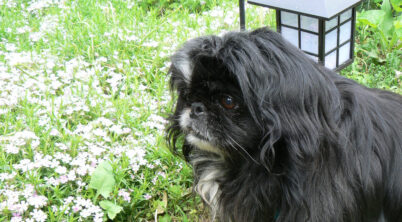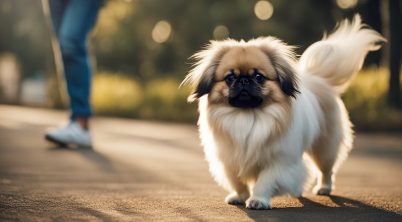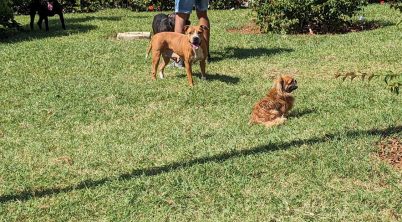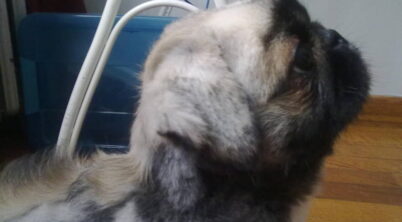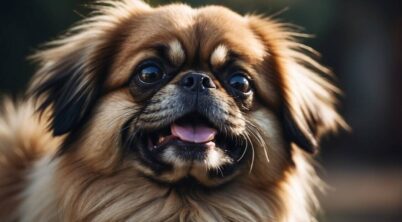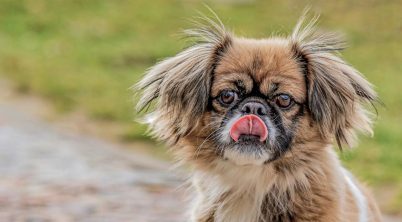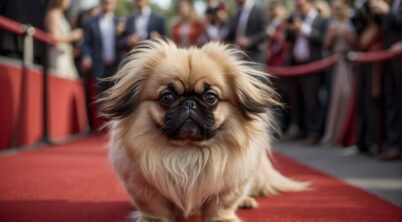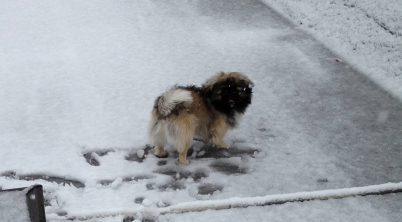The Pekingese, a toy dog breed with an illustrious origin in ancient China, is prized for its regal and companionship qualities. Recognized by the American Kennel Club for its distinctive features and history, the breed has long been considered a loyal and affectionate member of the family. Pekingese dogs are known for their loyalty, making them a potentially excellent choice for individuals seeking a devoted pet.
For prospective dog owners contemplating the Pekingese as their first pet, understanding the breed’s unique needs is crucial. These dogs carry themselves with a confident dignity and may require a special approach to training and socialization. The breed’s long, flowing coat, while beautiful, also demands regular grooming. Although their affectionate nature makes them endearing companions, Pekingese are better suited to homes with older children due to their independent and sometimes stubborn temperament.
When acclimating to life with a Pekingese, establishing a routine that includes gentle training, appropriate socialization, and adequate veterinary care is essential. Due to their stocky build and short muzzle, the Pekingese can quickly overheat in hot weather, so owners must be mindful of their dog’s comfort and health risks. By appreciating the heritage and characteristics of this ancient breed, first-time dog owners can foster a nurturing environment for their Pekingese to thrive.
Choosing the Right Pekingese
When selecting a Pekingese as a first-time dog owner, it’s essential to understand the unique aspects of the breed, from temperament and appearance to how they fit into various lifestyles. Here, we’ll guide you through making an informed decision.
Understanding the Pekingese Temperament
Pekingese dogs are known for their loyal and affectionate nature, but they can also display an independent and sometimes stubborn streak. They typically form strong bonds with their owners and are alert, which makes them excellent companions.
Physical Characteristics
Pekingese dogs have a distinctive double coat available in various colors, including red, black, sable, cream, and white. Their stocky build, flat face, and short snout categorize them as brachycephalic, with adults weighing between 7-14 lbs and standing about 6-9 inches tall.
Matching to Your Lifestyle
Pekingese can adapt well to apartment living due to their moderate energy level. They do have exercise needs that should be met with short walks or play sessions. This breed may not be the most suitable for families with very young children due to their size and temperament.
Finding a Reputable Breeder or Rescue
Seeking a reputable breeder or Pekingese rescue organization is crucial. They should provide health clearances and be transparent about any potential health issues. Considering adoption from a shelter is a worthy option as well.
Puppy vs. Adult Dog Considerations
A Pekingese puppy allows for early bond establishment and training adaptability, while an adult dog may have known temperament but could come with ingrained habits. Evaluating both options in the context of your lifestyle and commitment to training is essential.
Global Popularity and History
Originating from ancient China, the Pekingese was once an exclusive companion to Chinese emperors during the Tang Dynasty. They were brought to Europe after British troops invaded the Imperial Palace in Beijing, and one was even reported to survive the Titanic sinking.
Health and Care
When considering a Pekingese as a pet, first-time dog owners need to be well-informed about the specific health and grooming needs of this breed. Health issues unique to the Pekingese, its luxurious coat, tailored diet, and exercise requirements are crucial for maintaining the dog’s well-being.
Common Health Issues and Prevention
The Pekingese breed is predisposed to certain health issues. They are a brachycephalic breed, meaning they have short noses and flat faces, which can lead to breathing problems. To prevent complications:
- Regular Veterinary Check-ups: Schedule visits to monitor health and catch early signs of issues.
- Be Observant: Watch for signs of breathing difficulty, especially in hot weather.
Other health concerns include dry eye and progressive retinal atrophy, which can lead to blindness. Preventative care involves:
- Eye Examinations: Regular check-ups with a vet can detect early symptoms.
- Proper Care: Keep their eyes clean to prevent infections.
Grooming Essentials
Pekingese dogs have a luxurious, double-layered coat that requires regular grooming to avoid matting and shedding issues. Essential grooming practices include:
- Brushing: Several times a week with a bristle brush to prevent matting.
- Bathing: Monthly, with a gentle dog-specific shampoo.
- Nails: Trimmed regularly to prevent overgrowth which can cause discomfort.
Nutrition and Diet
Overseeing the diet of a Pekingese is important as they can easily gain weight. To ensure a balanced diet:
- Offer measured amounts of high-quality dog food twice a day.
- Limit treats to prevent weight gain.
Consult a veterinarian to tailor the diet to your dog’s age, size, and activity level.
Exercise Guidelines
Pekingese dogs have moderate exercise needs with a distinctive rolling gait. They are not overly energetic but do require daily exercise to maintain health. Keep in mind that:
- Short walks in cool weather are beneficial.
- Avoid strenuous activities, especially in heat, due to their sensitivity to breathing problems.
Never push the dog beyond its limits, and always provide water and shade during outdoor activities.
Training and Socializing Your Pekingese
Pekingese dogs are distinctive for their loyal and regal character, yet they can present unique challenges when it comes to training and socialization. These dogs thrive with positive reinforcement techniques, making early and consistent training important for a well-behaved pet.
Training Challenges and Tips
Training a Pekingese can be demanding due to their independent streak. Owners should establish a routine and stick to positive reinforcement methods such as treats or praise to encourage good behavior. Consistency is crucial, and short, engaging training sessions are more effective, as Pekingese can become bored with repetitive activities.
- Potty Training: Begin by taking them to a designated spot and praise them when they use it.
- Chewing and Biting: Provide appropriate chew toys and redirect bad behavior with gentle correction.
The Importance of Socialization
Socialization is vital for Pekingese, as it helps prevent the development of fearful or aggressive tendencies towards other dogs and people. Introduce the Pekingese to a variety of environments, animals, and people from a young age to ensure they become well-adjusted adults.
- Introductions to Families: Socialize gradually in controlled settings.
- New Environments: Regular exposure to different settings promotes adaptability.
Teaching Basic Commands and Tricks
Pekingese can learn a variety of commands and tricks, which can enhance their social skills and provide mental stimulation. Start with fundamental commands like sit, stay, and come, using treats as rewards for compliance.
- Sit Command:
- Hold a treat close to the Pekingese’s nose.
- Move your hand up, allowing their head to follow the treat and bottom to lower.
- Once they’re in a sitting position, say “Sit,” give them the treat, and share affection.
- Tricks:
- Roll Over: Teach this trick in steps, rewarding the Pekingese as they complete each part.
- High Five: Encourage them to paw at your open hand and reward with treats.
By tackling training and socialization with patience, assertiveness, and positive reinforcement, Pekingese owners can ensure their companion is both well-mannered and socially confident.
Living with a Pekingese
Living with a Pekingese can be a rewarding experience as these dogs are known for their affectionate nature and loyalty. They require daily care and interaction to thrive in a home environment.
Daily Routines and Interaction
The Pekingese breed benefits from consistent daily routines. They require moderate exercise to maintain their health, often content with short walks and playtime. Due to their affectionate disposition, Pekingese dogs seek regular interaction with their owners, enjoying activities that allow for companionship and socialization. However, it’s essential to monitor their activity, especially in hot weather, to prevent overexertion.
Integrating into a Multi-Pet Household
When introducing a Pekingese into a household with other pets, gradual socialization is key. This breed can be social and friendly but also has a strong independent nature. It’s vital to supervise early interactions to foster a peaceful coexistence. The Pekingese’s alertness makes them effective watchdogs, but early training is crucial to manage any overprotective behavior towards other pets.
Coping with Separation Anxiety
Pekingese dogs are companion-oriented, which can lead to separation anxiety if left alone for extended periods. Strategies to alleviate anxiety include:
- Establishing a safe space: Provide a comfortable area where the dog feels secure when you’re away.
- Routine practice: Gradually acclimate your Pekingese to being alone by increasing the duration of separation over time.
Owners should reinforce positive behavior to encourage their dog’s independent nature and reduce anxiety-related issues.
Adjustments for Aging Dogs
As Pekingese enter their senior years—boasting a lifespan that can reach into the teens—a few adjustments to their daily care will need to be made:
- Exercise: Short, gentle walks to maintain mobility without causing undue stress on their joints.
- Veterinary care: Regular check-ups to detect and manage age-related health issues.
Understanding and adapting to the evolving needs of an aging Pekingese can ensure a good quality of life throughout their golden years.
The Pekingese Community and Culture
The Pekingese breed has a storied history that intertwines with Chinese culture and dog-enthusiast communities worldwide.
Historical Significance and Legends
Within the culture dedicated to this breed, the Pekingese stands out for their historical significance extending back to ancient China. Legends say these dogs, often referred to as “lion dogs,” were companions of royalty, held in high esteem within the Imperial courts of the Chinese capital city. They are said to have been bred to resemble lions, which symbolized the Buddhist lion. Their presence was highly cherished, and owning one was once a privilege of the Chinese nobility.
The Pekingese Club of America plays a pivotal role in preserving the breed’s heritage and promoting its unique qualities. The organization sanctifies the breed’s history, upholding the legend that the Pekingese was created from the breath of the Chinese dragon, which endowed them with a courageous spirit.
The breed gained international prominence after the Opium War when British troops entered the Yuanmingyuan and brought these dogs to the Western world. The American Kennel Club (AKC), recognizing the Pekingese in 1906, categorizes them as a member of the Toy Group. Pekingese enthusiasts often exhibit these dogs in AKC-sanctioned dog shows, where their distinct personalities and stature are celebrated and can be seen in the show ring displaying their graceful gait and regal demeanor.
The Pekingese’s history is not just a tale of ancient times. The community that admires them today upholds the traditions through conformation shows, breed preservation activities, and education about their storied past. The courage and dignity enshrined in the Pekingese legacy continue to resonate within the collective spirit of Pekingese owners and admirers around the globe.
Conclusion
Adopting a Pekingese requires a lifestyle prepared for a long-term commitment. They are best suited for individuals or families who can spend ample time with them, as they form strong attachments to their owners. Pekingese are not a breed that should be left alone for long durations; they thrive on companionship and may suffer from separation anxiety if neglected.
The responsibility of owning a Pekingese involves ensuring their health and happiness. This breed demands consistent grooming due to its long, flowing coat. Potential owners must be ready to engage in regular grooming sessions to prevent matting and maintain overall coat health.
A Pekingese’s compact size might seem ideal for apartment living, but prospective owners should be aware that these dogs have a strong character and can be assertive. Training and socialization are imperative from an early age to foster well-behavior and adaptability.
In providing appropriate care, owners will find a loyal and affectionate companion in a Pekingese. The breed’s distinct personality and regal demeanor can be a source of joy for many years. Before deciding, it’s important to evaluate whether one’s lifestyle can accommodate the needs of this unique breed to ensure a harmonious relationship.
* Banner photo by Sharon Sipple, cropped | Some rights reserved

